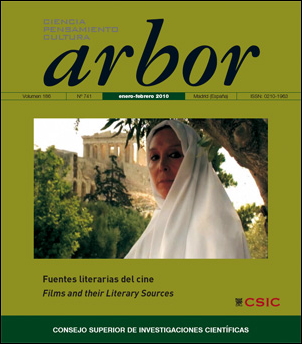La traslación de la mirada aborigen: Generación Robada y la mediación intertextual
DOI:
https://doi.org/10.3989/arbor.2010.741n1010Palabras clave:
Australia, aborígenes, generaciones robadas, intertextualidad, cine, relato oral, historiaResumen
Siguiendo el desarrollo reciente de los estudios sobre adaptación, que tienden a interrogar la relación intertextual entre el medio escrito y el cinematográfico, este artículo analiza la película Generación robada (Noyce, 2002), destacando la compleja intertextualidad que la compone: el libro que constituye el texto-fuente, Follow the Rabbit-Proof Fence (1996) de Doris Pilkington-Garimara; el informe Bringing Them Home (1997) sobre la separación forzada de niños aborígenes; los textos y actos políticos de la reconciliación nacional australiana y, finalmente, las biografías y la participación de las actrices aborígenes y sus comunidades. Todos ellos contribuyen a la traslación visual y la articulación de un film en el que la imbricación entre historia y arte es un elemento constitutivo.
Descargas
Citas
Brewster, Anne (2002): “Aboriginal life writing and globalisation: Doris Pilkington’s, Follow the Rabbit-Proof Fence”, Australian Humanities Review, 25. http//www.australianhumanitiesreview.org/archive/Issue-March-2002/brewster.html.
Brewster, Anne (2007): “The Stolen Generations: Rites of Passage: Doris Pilkington Interviewed by Anne Brewster”, Journal of Commonwealth Literature, 42.1, 143-159. doi:10.1177/0021989407075735
Cain, Deborah (2004): “A fence Too Far? Postcolonial Guilt and the Myth of distance in Rabbit-Proof Fence”, Third Text, 18: 4, 297-303. doi:10.1080/0952882042000229881
Hooks, Bell (1992): “The Oppositional Gaze: Black Female Spectators”, Black Looks, Race and Representation, Londres, turnaround, 115-131.
Hughes-D’aeth, Tony (2002): “Which Rabbit-Proof Fence? Empathy, Assimilation, Hollywood”, Australian Humanities Review 27. http://www.australianhumanitiesreview.org/archive/Issue-September-2002/hughesdaeth.html.
Human Rights and Equal Opportunities Commission (1997): Bringing Them Home, Report of the National Inquiry into the Separation of Aboriginal and Torres Straits Islander Children from Their Families.
Hucheon, Linda (2006): A Theory of Adaptation, N. York, Routledge.
Leitch, Thomas (2008): “Adaptation Studies at a Crossroads”, Adaptation, 1: 1, 63-77. doi:10.1093/adaptation/apm005
Manne, Robert (2002): “The Colour of Prejudice”, Sydney Morning Herald, 23 February.
McCarthy, Greg (2003): “The Obstinate Memory in Australian Films”, www.utas.edu.au/government/APSA/GMcCarthyfinal.pdf.
Mulvey, Laura (1975): “Visual Pleasure and Narrative Cinema”, Screen, 16.3, 6-18.
Olsen, Christine (2002): Rabbit-Proof Fence. The Screenplay. Sydney, Currency Press.
Pilkington-Garimara, Doris (1996): Follow the Rabbit-Proof Fence, St. Lucia: U. of Queensland P. (N. York, Miramax Books, 2002).
Potter, Emily y Kay Schaffer (2004): “Rabbit-Proof Fence Relational Ecologies and The Commodification of Indigenous Experience”, Australian Humanities Review, 31-32. http//www.australianhumanitiesreview.org/archive/Issue-April-2004/schaffer.html.
Spivak, Gayatri Chakravorty (1988): “Can the subaltern speak?” Marxism and the Interpretation of Culture, ed. C. Nelson y Larry Grossberg. Urbana: U. of Illinois Press, 271-313.
Watson, Christine (2002): “Nugi Garimara (Doris Pilkington) Interviewed by Christine Watson”, Hecate, 1 mayo 2002.
Descargas
Publicado
Cómo citar
Número
Sección
Licencia
Derechos de autor 2010 Consejo Superior de Investigaciones Científicas (CSIC)

Esta obra está bajo una licencia internacional Creative Commons Atribución 4.0.
© CSIC. Los originales publicados en las ediciones impresa y electrónica de esta Revista son propiedad del Consejo Superior de Investigaciones Científicas, siendo necesario citar la procedencia en cualquier reproducción parcial o total.
Salvo indicación contraria, todos los contenidos de la edición electrónica se distribuyen bajo una licencia de uso y distribución “Creative Commons Reconocimiento 4.0 Internacional ” (CC BY 4.0). Consulte la versión informativa y el texto legal de la licencia. Esta circunstancia ha de hacerse constar expresamente de esta forma cuando sea necesario.
No se autoriza el depósito en repositorios, páginas web personales o similares de cualquier otra versión distinta a la publicada por el editor.














